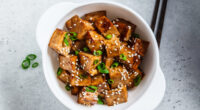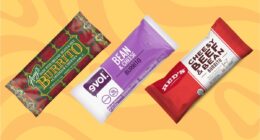How much sugar per day do Americans consume? According to Centers for Disease Control and Prevention, average sugar consumption in America is around 17 grams per day of added sugar, or 270 calories, while total sugar consumption is estimated to be around 94 grams to 126 grams per day for the average American.
That’s a lot of sugar, but it doesn’t have to be this way. In fact, you can even follow a sugar-free diet (aka no-sugar diet) to help lower this number greatly.
A great deal of research has shown that removing sources of excess sugar from your diet not only helps with weight loss, but can also reduce your risk for common health problems, like type 2 diabetes, digestive problems, autoimmune conditions and more.
Cutting out sugar is a great way to detox your body because excess sugar is bad for you.
So, what can you eat that has no sugar in it but is still satisfying?
Proteins — like grass-fed meat, eggs or fish, for example — lots of veggies, healthy fats, nuts, seeds and other detoxifying foods are where you’ll get the bulk of your calories when eating a low-sugar or sugar-free diet.
While the transition away from eating lots of sugar might seem hard at first, provoking cravings and even other symptoms that can mimic a “withdrawal,” within a few weeks you’ll likely see your efforts start to pay off on a no-sugar diet.
High sugar consumption can increase inflammation, mess with hormone production, rob you of energy, and even interfere with your mood and sleep.
That’s why kicking your sugar addiction, replacing “empty”calories with nutrient-dense ones, will noticeably change you how you feel, both mentally and physically, in many ways.
What Is a Sugar-Free Diet?
A sugar-free diet (or no-sugar diet) is one that typically limits all sources of added sugar (like soda, snack bars and desserts, for example) and hidden sugar foods, and it sometimes also encourages a reduction in high-carbohydrate foods (like grains or fruits) that can still be healthy but do contain natural sugars.
There isn’t just one way to eat a low-sugar diet, but rather a variety of different plans depending on your goals and preferences. You might choose to eliminate basically all sources of sugar from your diet, including things like fruit and even some veggies, or to only eliminate sweetened processed foods that are high in empty calories.
Either way, there are lots of benefits to consuming more satisfying, nourishing foods in sugar’s place, such as lean proteins and healthy fats.
Another perk is that most low-sugar or sugar-free diets don’t require calorie counting, since eliminating ultra-processed foods is usually enough to produce results on its own.
How to Consume Less Sugar
In order to reduce your sugar intake and deal with cravings for sweets or refined carbohydrates — a very common problem among most people looking to lose weight or improve their eating habits — there are some simple steps you can take to consume less sugar and move toward a no-sugar diet.
1. Start slowly
Begin by identifying how much sugar you currently consume, and set achievable targets for reduction. Aim to cut back by 10% to 20% in the first week, and slowly increase from there.
Instead of cutting out sugar entirely, replace sugary snacks with healthier options. For example, swap candy for fruit.
2. Read food and ingredient labels
Read ingredient labels carefully when grocery shopping in order to know just what you’re consuming, since most people don’t realize how much sugar they’re really eating or drinking. This is especially important when buying or using “sneaky” sugary foods like condiments, sauces, canned foods, beverages, etc.
3. Be wary of simple carbohydrates and junk foods
As you familiarize yourself with food labels, look for ingredients like high fructose corn syrup, sucrose and glucose. Many refined carbs have added sugar, and most ultra-processed foods, including snacks, sauces and beverages, contain high levels of added sugars.
Simple carbohydrates like white bread, pasta and rice can be replaced with whole grain varieties.
4. Focus on consuming whole foods
Opt for whole, unprocessed foods when possible. Incorporate a variety of fresh fruits and vegetables into your diet. They are naturally sweet and packed with vitamins and minerals.
Choose whole grains like brown rice, quinoa and oats over refined grains. They provide more fiber and nutrients, which can help stabilize blood sugar levels.
In addition, most lean meats, poultry, wild-caught fish, legumes, nuts, seeds and tempeh are fair game on a no-sugar diet.
5. Plan your meals
Plan your meals for the week to avoid last-minute unhealthy choices. Include a variety of whole foods to keep meals interesting.
Prepare healthy snacks in advance, such as nuts, yogurt or cut-up vegetables, to avoid reaching for sugary options when hunger strikes.
Here are some examples of sugar-free meals you can prepare:
- For breakfast — unsweetened oats with nuts, seeds, coconut milk, stevia and cinnamon; avocado toast with hard-boiled eggs; unsweetened goat’s milk yogurt with grain-free granola; a homemade green smoothie.
- For lunch — a large salad with sliced chicken and avocado; some quiche with soup and a salad; a salmon or turkey burger; homemade brown rice bowl with veggies and beans.
- For dinner — a palm-sized serving of steak with veggies, and possibly some rice or quinoa; a piece of fish with salad, veggies and half a sweet potato; a burrito, tacos or empanadas made with chorizo and veggies; balsamic chicken with tomato and mozzarella; brown rice, broccoli and chicken stir-fry.
6. Spice up your plate for added flavor
Experiment with herbs and spices to add flavor to your meals without the need for sugar. Options like cinnamon, ginger, garlic and fresh herbs can elevate your dishes — plus they provide a wealth of health benefits.
You also can incorporate lemon juice or vinegar into your meals for a zesty kick that enhances flavor without adding sweetness.
7. Eat more fiber
To keep your appetite in check, aim to get about 35–40 grams of fiber per day. Start by consuming more high-fiber foods like fresh vegetables and nuts and seeds, such as chia seeds and flaxseeds.
8. Stay hydrated
Drink enough water to help with digestion and elimination and stay hydrated. Aim to have about eight glasses per day and even more when the weather is warm or you are physically active.
9. Use natural sweeteners like stevia
If you do need to sweeten foods, try stevia first (rather than artificial sweeteners). If you can’t stand the taste of stevia, in small amounts you may want to use some natural sweeteners from time to time, such as raw honey, blackstrap molasses, dates or pureed fruit (like bananas or apples).
10. Limit caffeine and especially alcohol
Avoid too much caffeine or alcohol. Many mixed drinks tend to be high in sugar and calories — plus alcohol can spike your appetite and cause cravings.
11. Avoid or at least limit packaged and fast food
Even if the food is low in sugar/carbs, try to limit packaged foods from your diet that are highly processed and very salty. Many contain a host of additives, preservatives, flavorings, emulsifiers and other substances, in addition to both added and natural sugars.
Additionally, replace fast foods and fried foods with healthier options you can cook at home — this way you can control the ingredients.
12. Skip artificially sweetened foods and know other names for sugars
Avoid eating foods with the following types/names of sugar and sweeteners:
It’s important to note that some natural sweeteners are still sugars, including coconut sugar, maple syrup and honey, so take note of how much you consume if you’re moving toward a no-sugar diet. While they can be healthy substitutes, moderation is key.
13. Replace sugary drinks with healthy ones
Don’t drink your calories. Avoid soda, commercial juice or artificially sweetened drinks.
Instead of adding sugar to beverages, try consuming plain water, seltzer, herbal tea, bone broth or black coffee. In moderate amounts, unsweetened coconut milk or coconut water can also be a good choice.
14. Eat more protein, healthy fats and fermented foods
Aim to eat balanced meals that include a healthy source of protein, some veggies and some healthy fat. This combination will help keep you more satisfied, energized and focused throughout the day.
In addition, t’s recommended to avoid most “low-fat” foods that often contain high amounts of sugar. Yogurt, salad, breakfast cereals, peanut butter, cereal bars, etc. have low-fat versions that are all higher in sugar than their full-fat counterparts.
Full-fat varieties also help keep you fuller longer and don’t affect overall blood sugar levels as much.
If you include some carbohydrates, try to make it a complex carb that has some fiber, and keep an eye on your portion sizes.
By following these steps, you can gradually reduce your sugar intake and develop healthier eating habits.
Remember, the key is to make sustainable changes that you can maintain over time.
Health Benefits
Some of the benefits of reducing your sugar intake in place of eating more whole foods include:
- Help with losing weight and preventing obesity
- Lowered risk for type 2 diabetes or prediabetes
- Gaining more energy
- Having more stable moods
- Reduced risk for inflammatory digestive conditions, such as irritable bowel disease, Crohn’s disease, candida, irritable bowel syndrome, and intolerance to wheat/gluten or FODMAP foods — many also notice less constipation, diarrhea, stomach bloating or acid reflux
- When sugar contributes to obesity, a sugar-free diet lowers risk for conditions related to metabolic syndrome, such atherosclerosis, hypertension and heart disease
- Possibly less risk for cancer
- Protection against fatty liver disease
- Better protection against other common conditions related to inflammation, weight gain and nutrient deficiencies, like hemorrhoids, kidney stones, peptic ulcer, PMS, autoimmune diseases, polycystic ovarian syndrome, and neurological diseases like dementia or Alzheimer’s disease
Why is a high-sugar diet bad for you?
Sugar can change the gut microbiota in a way that increases intestinal permeability, raising inflammation. It can also contribute to overeating and obesity, causing many negative changes in the body.
Eating a low-sugar, low-glycemic index diet can help balance your blood sugar levels throughout the day, prevent insulin resistance (one long-term effect of a high-sugar diet), protect you from fatty liver disease and heart disease, control your appetite, and keep you fuller and energized for longer.
A low-sugar or sugar-free diet is very similar to what’s called a “low-glycemic index diet.” The definition of the glycemic index (GI) is “a measure of the blood glucose-raising potential of the carbohydrate content of a food, compared to a reference food (generally pure glucose, or sugar).”
A food’s GI number tells you how quickly the food is converted into sugar once you eat it. The higher the GI number, the more drastically the food will cause your blood sugar level to increase.
All carbohydrates increase blood glucose (sugar), but this doesn’t mean that all carbohydrates are necessarily unhealthy and should be avoided. Sugary, processed foods impact blood glucose levels a lot more than whole, unprocessed foods.
For example, table sugar, white bread, white rice, white potatoes, white flour and all other types of sweeteners have high GI values.
Factors that determine a food’s GI value include how much sugar the food contains, how processed it is, the fiber content and what other types of foods it’s paired with. (This determines “the glycemic load.”)
The types of high-GI foods that contain lots of added sugar and/or refined grains that you should remove from your diet include:
- refined grain products made with white flours
- most breads, processed breakfast cereals, cookies, snack bars, cakes, desserts, etc.
- sweetened dairy products
- sweetened beverages, such as soda and bottled juices
- all types of table/cane sugar
Sometimes all other natural sweeteners should be excluded, too, depending on the state of your health, like honey, syrups, molasses, etc., and in some cases, other sweet ingredients like dried fruits (raisins, craisins and dates) and starchy root vegetables (like white potatoes, beets or winter squash) need to be limited in order to see results.
Healthy Sugar-Free Foods
Healthy protein foods:
- Grass-fed beef, lamb, venison or other game
- Free-range poultry, like chicken or turkey
- High-quality protein powders, including bone broth, collagen, whey protein (ideally from raw goat milk) or pea protein
- Lentils, beans and other legumes (ideally soaked and sprouted to help with digestion)
- Wild fish, like salmon, mackerel, tuna, etc.
- Organic natto or tempeh (fermented soybean product)
- Raw milk and fermented dairy products, like kefir or yogurt
- Free-range eggs
- Raw cheese
High-fiber foods (may contain small amounts of natural sugars):
- Cruciferous veggies, like cabbage, broccoli, Brussels sprouts, etc.
- Other veggies (aim for a combination of cooked and raw), like bell peppers, cucumber, carrots, green peas, okra, turnips, squash, zucchini, asparagus, tomatoes, mushrooms, artichokes, etc.
- Chia seeds and flaxseeds
- Avocados
- Coconut flakes
- Berries
- Beans, like black beans, navy beans, adzuki, lentils, lima, split, mung, etc.
- In moderate amounts, whole grains like quinoa, brown rice, oats, amaranth, buckwheat, teff, farro, etc.
- In smaller amounts, other fruits that are a bit higher in sugar, like apples, bears, figs, prunes, oranges, grapefruit, melon or kiwi
Healthy fats:
- Coconut oil, milk, butter or cream
- Real virgin olive oil
- Grass-fed butter
- Nuts, like walnuts, almonds, cashews, Brazil nuts, etc.
- Seeds, like chia, flax, pumpkin, sunflower, etc.
- Avocado
- Other oils, like MCT oil, palm fruit oil, hemp seed, flaxseed, avocado oil, etc.
Sour foods, probiotic foods and other detoxifying ingredients:
- Cultured veggies, like salted gherkin pickles, olives or kimchi
- Kombucha or coconut kefir
- Natto, tempeh or miso
- Kvass
- Raw cheese
- Lemon and lime juice
- Apple cider vinegar (use some in salad dressing or in water with some lemon juice)
- Bone broth
- All fresh herbs and spices, like ginger, garlic, parsley, oregano, turmeric, etc.
- Stevia (extract, green crystalized or drops) — is a no-calorie, natural sweetener that makes a good sugar substitute in recipes. Use it in drinks or on foods in place of regular white table sugar.
No-Sugar Diet vs. Other Diets
How does a sugar-free diet compare to the ketogenic diet and other low-carb diets?
- If you exclude all sources of sugar from your diet, you’re already on your way to eating a low-carb diet, since sugary foods provide the body with high amounts of glucose. Once glucose supply is reduced, the body burns fat for fuel instead of glucose from carbohydrates or sugar.
- When sugar is taken out of the equation, your carb intake then depends on how many grains, veggies, legumes and other sources of carbs you still eat in proportion to fats and protein.
- The keto diet is a very low-carb diet that includes virtually no sugar and only about 20–50 grams of net carbs daily. The majority of calories on the keto diet come from fats, like coconut oil, butter or fattier cuts of meat. Sugary, high-carb foods are eliminated, including grains, fruit, dairy and beans.
- A sugar-free diet is one type of low-carb diet plan, among many different variations. How many carbs are typically in a low-carb diet? It depends a lot on the individual plan being followed, but most moderate plans range from about 50–130 grams of net carbs daily. Usually the lower the carb intake, the faster that weight loss will happen. However, a very low-carb diet isn’t always sustainable for some people or realistic, so a moderate low-carb plan may be a better fit.
What Natural Sugars Are Necessary for Health?
If you’re looking to start a low-carb or sugar-free diet, you may be wondering if you’ll still eat enough “healthy carbohydrates” to keep your body functioning properly. While it’s true that we all need at least some carbohydrates in order to fuel physical activity, repair damaged tissue, and supply our bodies and brains with energy, the amount we need is less than most people typically consume.
Here are some of the reasons that you’ll want to keep at least some carbohydrates in your diet, which may include some natural sugars found in things like fruits or veggies:
- Plant-based foods that contain carbohydrates, and sometimes natural sugars, also provider dietary fiber. Fiber does not actually get fully digested once consumed, which is why people following a low-carb diet usually don’t count grams of fiber toward their net carb intake. Net carbs are the grams of carbs left over when grams of fiber are subtracted from the total amount.
- Fiber is needed for digestive health, cardiovascular health and controlling appetite hormones.
- Fiber is also typically found in low-calorie foods that are high in vitamins, minerals and antioxidants. For example, high-fiber foods include leafy green veggies, berries, apples, beans, seeds avocados and sweet potatoes. Not all of these foods are “sugar-free,” but the sugar they do contain is naturally occurring and often not a problem considering all the other nutrients available in the food.
- The whole foods described above are low in calories but good sources of electrolytes, like potassium and magnesium, as well as antioxidants like carotenoids, beta-carotene, lycopene, vitamin E and vitamin C.
Compared to a sugar-free diet, what foods would be included in a grain-free or wheat-free diet?
A grain-free diet/gluten-free diet eliminates all grains, especially wheat, but this doesn’t mean it’s necessarily low in sugar.
Gluten is a protein found in wheat, barley and rye. A gluten-free diet, therefore, removes all sources of these grains, including most baked goods, bread, rolls, desserts, cereal, etc.
A grain-free diet takes things a step further and also removes ALL other grains, like quinoa, oats, buckwheat, etc. If sugar is also removed from these diets, then it’s basically the same thing as eating a low-carb diet.
Risks and Side Effects
Depending on how many carbohydrates you continue to consume once cutting out sugar, you may notice some side effects when changing your and moving toward a no-sugar diet. Usually these will go away within one to three weeks as your body gets used to eating less processed foods and consuming more healthy fats and fiber.
You may want to transition into a lower-carb, sugar-free diet gradually in order to help your digestive system and appetite adjust. While altering your diet, it isn’t unusual to temporarily experience some of the following side effects:
- Low energy or fatigue
- Digestive issues, like bloating or gassiness
- Cravings
- Brain fog
- Changes in your sleep and appetite
Final Thoughts
- A sugar-free diet (or no-sugar diet) is a diet that excludes added sugars and most processed foods. This type of diet is similar to a low-glycemic index diet and low-carb diet in that it helps reduce your body’s reliance on glucose (sugar) for energy.
- Benefits of a sugar-free diet potentially include weight loss, helping normalize blood sugar, preventing insulin resistance, reducing cravings, giving you more energy and keeping you feeling fuller for longer after eating.
- To reduce the amount of sugar in your diet, try focusing on making some of the following changes: Reduce or avoid sugary foods like cookies, cakes, candy and soft drinks; pair carbohydrates with proteins and healthy fats to make your meals more satisfying; consume unprocessed complex carbs instead of simple carbs; lower your intake of flour and white refined grains; eat more high-fiber foods like veggies, beans, legumes, nuts and seeds; and eat smaller amounts of starchy foods like white potatoes, white bread, rice, etc.





